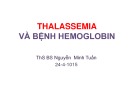
Bài giảng Bệnh Hemoglobin và Thalassemia
-
Thalassemia là nhóm bệnh máu di truyền có đặc điểm chung là nồng độthalassemia giảm. Huyết sắc tố là một loại protein trong hồng cầu có chức năng vận chuyển oxy và dicacbonic, một phân tửthalassemia có hai phần là hem và globin.
 42p
42p  huynhhuuviet
huynhhuuviet
 11-06-2011
11-06-2011
 314
314
 47
47
 Download
Download
-
Bài giảng Di truyền phần tử các bệnh bao gồm những nội dung về di truyền phần tử của các bệnh BetaThalassemia; bệnh của hemoglobin do bất thường chất lượng chuỗi globin; bệnh hemoglobin E; bệnh thalassemia; bệnh phenylxeton niệu; bệnh đái tháo dường và một số bệnh khác. Mời các bạn tham khảo.
 87p
87p  thuytrang_6
thuytrang_6
 17-08-2015
17-08-2015
 217
217
 36
36
 Download
Download
-
Nội dung bài giảng trình bày khái niệm bệnh Thalassemia, bệnh hemoglobin, đặc điểm bệnh, xét nghiệm chẩn đoán, đặc điểm di truyền của bệnh.
 52p
52p  uocvong09
uocvong09
 16-10-2015
16-10-2015
 339
339
 33
33
 Download
Download
-
Bài giảng Đột biến gen với mục tiêu nhằm giúp các bạn trình bày được các nguyên nhân và cơ chế gây nên một số kiểu đột biến gen; Giải thích được cơ chế ở mức phân tử một số bệnh đột biến ở người (Hemoglobin, Thalassemia, Xeroderma Pigmentosum). Mời các bạn cùng tham khảo!
 76p
76p  baphap06
baphap06
 31-01-2023
31-01-2023
 14
14
 4
4
 Download
Download
-
Bài giảng cung cấp các kiến thức giúp sinh viên có thể biết được định nghĩa và sinh lý bệnh Thalassemia và bệnh Hb, biết được cách phân loại của bệnh Thalassemie và bệnh Hb, hiểu rõ tiêu chuẩn chẩn đoán xác định bệnh, nắm được các yếu tố tiên lượng và diễn tiến bệnh, nắm được các biện pháp điều trị bệnh. Mời các bạn cùng tham khảo.
 9p
9p  tramnamcodon_01
tramnamcodon_01
 28-03-2016
28-03-2016
 173
173
 21
21
 Download
Download
-
HbA, nằm trên cánh ngắn nhiễm sắc thể 16 (16p13.3) gây ra sự giảm hoặc mất tổng hợp chuỗi alpha globin. Hemoglobin ở người trưởng thành bình thường có 2 chuỗi alpha globin và 2 chuỗi beta globin. Chuỗi alpha globin được tổng hợp từ 4 gen, trong đó có 2 gen HbA1 và 2 genHbA2. Số lượng của alpha globin phụ thuộc vào số gene hoạt động. Người càng có ít gene hoạt động thì càng mắc thể bệnh alpha thalassemia nặng hơn....
 7p
7p  shift_12
shift_12
 18-07-2013
18-07-2013
 74
74
 6
6
 Download
Download
CHỦ ĐỀ BẠN MUỐN TÌM


















